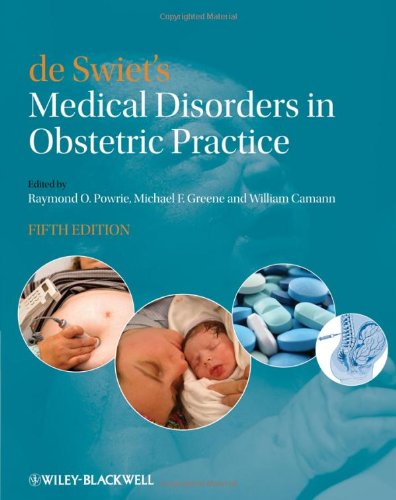(EBOOK PDF)de Swiet’s Medical Disorders in Obstetric Practice 5th Edition by Raymond Powrie, Michael Greene, William Camann 9781405148474 full chapters
$50.00 Original price was: $50.00.$35.00Current price is: $35.00.
de Swiet’s Medical Disorders in Obstetric Practice 5th Edition by Raymond Powrie, Michael Greene, William Camann – Ebook PDF Instant Download/Delivery: 9781405148474
Full download de Swiet’s Medical Disorders in Obstetric Practice 5th Edition after payment

Product details:
• ISBN 13:9781405148474
• Author:Raymond Powrie, Michael Greene, William Camann
Pregnancy affects the physiology of women as their bodies adapt to the growing life within them; but how does this affect how you manage general, or pre-existing medical complaints?
How do you differentiate the effects of pregnancy from genuine medical conditions? What are the effects of the ‘standard’ treatments on the growing fetus? What about breastfeeding?
In this brand-new edition of de Swiet’s Medical Disorders in Clinical Practice, expert physicians present the best evidence and practical wisdom to guide you and your patients through their pregnancy and illness, to a successful birth and early motherhood. Using a combination of algorithms, years of experience and an evidence-based approach, this book will help you to:
Diagnose difficult to identify conditions during pregnancy
Effectively prescribe for pregnant and lactating women
Overcome the challenges of imaging, anesthesia and critical care for pregnant women
de Swiet’s assists you in navigating the many challenges pregnancy presents for both the patient and physician.
de Swiet’s Medical Disorders in Obstetric Practice 5th Table of contents:
1. Pulmonary disease in pregnancy
Introduction
Physiologic adapations to pregnancy
Specific conditions
Asthma
Smoking cessation in pregnancy
Respiratory tract infection
Ventilatory support in pregnancy
Amniotic fluid embolism
Pulmonary hypertension
Obstructive sleep apnea
Cystic fibrosis
Chronic obstructive pulmonary disease
Kyphoscoliosis
Erythema nodosum
Sarcoidosis
Wegener’s granulomatosis
Pulmonary lymphangioleiomyomatosis
Idiopathic pulmonary fibrosis
Churg–Strauss syndrome
Lung cancer
Pneumothorax and pneumomediastinum
Pleural effusion
Anesthetic considerations
2. Hematologic disease in pregnancy
Anemia
The hemoglobinopathies and thalassemias
Thrombocytopenia and other platelet disorders in pregnancy
Bleeding disorders
3. Thromboembolic disease in pregnancy
Introduction
Investigation for venous thromboembolism in pregnancy
Acute treatment of venous thromboembolism
Maintenance treatment of venous thromboembolism
Prevention of venous thromboembolism in pregnancy
Anesthetic issues related to venous thromboembolism and anticoagulation
4. Thrombophilias and pregnancy
Physiologic changes of the hemostatic system in pregnancy
Introduction to thrombophilia
Management of thrombophilic pregnancies
Anesthetic concerns related to thrombophilias and thromboembolic disease in pregnancy
Conclusion
5. Heart disease in pregnancy
Introduction
Physiologic changes of pregnancy
Counseling patients
Management: general principles
Specific lesions
Anesthetic concerns for pregnant women with cardiac disease
Acknowledgment
Inspection
Palpation
Auscultation
6. Hypertension in pregnancy
Cardiovascular changes in pregnancy
Hypertension in pregnancy: introduction
Pre-eclampsia
Other causes of hypertension in pregnancy
Secondary hypertension
The fetus in hypertensive pregnancies
Anesthesia concerns for women with pre-eclampsia
Conclusions
7. Renal disease in pregnancy
Introduction
Changes in renal physiology in normal pregnancy
Chronic kidney disease outside pregnancy
Urinary tract infection
Acute renal failure
Renal calculi in pregnancy
Renal transplantation in pregnancy
Anesthetic management of parturients with renal impairment
Models of antenatal care for women with renal disease
8. Rheumatologic disorders in pregnancy
Introduction
Inflammatory arthritis
Systemic lupus erythematosus
Antiphospholipid syndrome
Scleroderma
Vasculitis
Neonatal lupus
Management of rheumatic diseases in pregnancy
Conclusion
9. Disorders of the liver, biliary system and exocrine pancreas in pregnancy
Normal liver physiology in pregnancy
Maternal hyperbilirubinemia and the fetus
Viral hepatitis and pregnancy
Autoimmune hepatitis
Intrahepatic cholestasis of pregnancy
Wilson’s disease
Hemochromatosis
Biliary disease
Gallstones and cholescystitis
Primary biliary cirrhosis, primary sclerosing cholangitis and biliary atresia
Budd–chiari syndrome
Cirrhosis and portal hypertension
Liver transplantation
Acute fatty liver of pregnancy
Pancreatic disease
Anesthetic concerns in patients with liver disease
10. Disorders of the gastrointestinal tract in pregnancy
Physiologic changes in the gastrointestinal system in pregnancy
Disorders of the oral cavity
Gastroesphageal disorders
Disorders of the intestinal tract
Anorectal and perineal disorders
Malignancy
Common nonobstetric causes of abdominal pain
Nutrition in pregnancy
Special considerations in antenatal care, labor and delivery, and puerperal care of patients with stomas
Endoscopy in pregnancy and lactation
Anesthetic considerations when caring for women with gatrointestinal disease in pregnancy
11. Diabetes mellitus in pregnancy
Introduction
Maternal energy metabolism and the role of insulin
Gestational diabetes
Effects of diabetes on the fetus and neonate
Medical management
Diabetic ketoacidosis
Conclusion
12. Thyroid disease in pregnancy
Introduction
Normal physiologic changes in pregnancy
Autoimmune thyroid disease
Hyperthyroidism
Hypothyroidism
Postpartum thyroiditis
13. Pituitary and adrenal disease in pregnancy
Anterior pituitary
Posterior pituitary
Adrenals
14. Calcium metabolism and diseases of the parathyroid glands during pregnancy
Calcium and phosphate homeostasis during pregnancy and lactation
Vitamin D deficiency
Parathyroid disease
Obstetric and perinatal care
Magnesium and calcium interaction
15. Neurologic disorders in obstetric practice
Introduction
Neurologic assessment
Multiple sclerosis
Stroke
Epilepsy
Central nervous system tumors
Mononeuropathies
Myasthenia gravis
Headache
Anesthetic considerations for obstetric patients with neurologic disease
16. Nonviral infectious diseases in pregnancy
Fever and host immune response in pregnancy
Genital infections in pregnancy
Nongenital infections in pregnancy
Puerperal infections
Obstetric anesthesia concerns related to thermoregulation and infection in pregnancy
17. Viral infections in pregnancy other than human immunodeficiency virus
Introduction
Pathogenesis of viral infections during pregnancy
Immune response to viral infections during pregnancy
Diagnosis of viral infections during pregnancy
Viral infections of predominantly maternal impact
Viral infections of predominantly fetal impact
Viral infections that affect both maternal and fetal health
Viral infections that affect both maternal and neonatal health
Viral infections that result in increased neonatal morbidity
Other viral infections in pregnancy
Immunization during pregnancy and breastfeeding
18. Human immunodeficiency virus infection in pregnancy
Introduction
Epidemiology of human immunodeficiency virus infection in women
Screening for human immunodeficiency virus infection in pregnancy
Diagnostic tests for human immunodeficiency virus infection
Pathogenesis of human immunodeficiency virus infection
Preconception counseling
Antepartum management
Management of labor and delivery
Postpartum management
Conclusion
19. Substance misuse in pregnancy
Introduction
Definitions
Prevalence of substance use in young women
Substance use during pregnancy
Mortality
Morbidity
Effect of substance misuse on pregnancy and the neonate (Table 19.3)
The impact of parental substance misuse on children
Effect of pregnancy on substance misuse
Overarching principles of treatment
Screening and detection
Management of substance misuse in pregnancy
Postnatal interventions
Special groups
Child protection
Model service development
Cost-effectiveness
Policy recommendations
Obstetric anesthesia concerns in relation to substance misuse
Conclusion
20. Skin diseases in pregnancy
Drug therapy during pregnancy
Physiologic skin changes in pregnancy
Dermatoses specific to pregnancy
The effect of pregnancy on other dermatoses
General recommendations about dermatologic medication use during pregnancy
Skin disorders and neuraxial anesthesia
21. Psychiatric disorders in pregnancy
Introduction
Major depressive disorder
Bipolar disorder
Schizophrenia
Panic disorder and generalized anxiety disorder
Obsessive compulsive disorder
Post-traumatic stress disorder
Eating disorders
Conclusion
22. Cancer in pregnancy
Introduction
Cervical neoplasia complicating pregnancy
Breast cancer in pregnancy
Malignant melanoma in pregnancy
Malignant ovarian masses in pregnancy
Hematologic malignancies in pregnancy
23. Critical care in pregnancy
Introduction
Epidemiology of critical illness in pregnancy
Organization of the intensive care unit
Indications for intensive care unit admission
Obstetric versus medical disorders
Antepartum versus postpartum intensive care unit admissions
Initial assessment of a critically ill patient
Comprehensive maternal and fetal evaluation
Organ dysfunction and failure
Cardiovascular dysfunction
Respiratory failure
Renal failure
Acute hepatic dysfunction
Central nervous system dysfunction
Coagulation failure
Delivery of critically ill patients
Intrapartum management
Prevention of thromboembolic disease
Prognosis and outcomes
Conclusion
24. Embryologic and fetal development
25. Global issues in maternal health
Introduction
Levels and causes of maternal mortality and morbidity
The role of medical disorders in maternal mortality
Global issues in obstetric anesthesia
26. Future health concerns for women who have had a complicated pregnancy
Introduction
Pre-eclampsia (see chapter 6)
Preterm birth and fetal growth restriction
Eclampsia
Pre-eclampsia and future kidney disease
Pre-eclampsia and future cancer
Pregnancy-induced hypertension
Thrombosis during pregnancy (see chapters 3 and 4)
Gestational diabetes mellitus (see chapter 11)
Gestational diabetes insipidus
Thyroid disease (see chapter 12)
Liver disease (see chapter 9)
Peripartum cardiomyopathy (see chapter 5)
Postpartum depression (see chapter 21)
Pregnancy in later life (see chapter 28)
Conclusion
27. Special concerns for the obese patient
Introduction
The obesity epidemic
Risks associated with obesity in pregnancy
Obesity and the risk of cesarean delivery
Additional implications for management
Anesthesia
Weight loss interventions
Conclusion
28. Special concerns for patients with advanced maternal age
Introduction
Preconception evaluation of older women considering pregnancy
Early pregnancy
Late pregnancy
Management of labor and delivery
Maternal mortality
29. Principles of obstetric anesthesia
Introduction
Preanesthetic care
Principles of regional anesthesia for normal labor and delivery
Principles of general anesthesia for cesarean delivery
Aspiration pneumonitis prophylaxis
Principles of regional anesthesia for cesarean delivery
Pain relief following cesarean delivery
Ambulatory/mobile/walking epidurals and combined spinal-epidural for labor and delivery
Successful interdisciplinary team work
Urgent/emergency cesarean delivery
Airway emergencies
Hemorrhagic emergencies (see also chapter 2)
Other specific circumstances
Conclusion
30. Prescribing in pregnancy: a practical approach
Introduction
General approach
Have a plan for drug treatment options
Conclusion
Disclaimer
31. Prescribing during lactation
Introduction
The alveolar subunit
Drug transfer into human milk
Bio-availability
Calculating infant dose
Conclusion
32. Diagnostic imaging in pregnancy
Introduction
Absorbed dose
Ultrasound and magnetic resonance imaging
Fetal absorbed radiation with x-rays and computed tomography
Fetal absorbed radiation with nuclear medicine imaging
Risks of radiation in pregnancy
Timing and fetal effects of radiation
Iodinated contrast
Maternal risks from radiation in pregnancy
Informed consent
33. Contraception for women with medical disorders
34. Effect of pregnancy on common laboratory tests
35. Approach to headaches in pregnancy
Introduction
Primary headaches
Secondary headaches
Evaluation
36. Approach to anemia in pregnancy
Introduction
Definition in pregnancy
Clinical consequences of anemia in pregnancy
Approach to anemia
37. Approach to moderately elevated liver function tests in pregnancy not attributable to pre-eclampsia/HELLP syndrome
Introduction
Diagnosis
Evaluation of elevated transaminases
Conclusion
38. Approach to shortness of breath in pregnancy
Introduction
Physiologic changes
History
Physical examination
Diagnostic testing
39. Approach to hypertensive emergencies in pregnancy
Introduction
What is severe hypertension?
How should patients with severe hypertension be assessed?
How urgent is it to treat severe hypertension?
Which antihypertensive agents should be used to treat severe hypertension?
What other monitoring or treatment is advised?
Anesthetic considerations
40. Approach to palpitations in pregnancy
Introduction
History
Physical examination
Investigations
Conclusion
41. Approach to proteinuria identified remote from term
Introduction
Physiology of proteinuria
Types of proteinuria
Measurement of proteinuria
Differential diagnosis of proteinuria
Evaluation of proteinuria
Evaluation of proteinuria based on clinical presentation
Nephritic renal disease
Nephrotic renal disease
Conclusion
42. Approach to new-onset hypertension remote from term
Introduction
Screening for secondary causes of hypertension
Evaluation for end-organ damage
Assessment of cardiovascular risk factors
Evaluation of hypertension
Conclusion
43. Approach to presyncope and syncope in pregnancy
Introduction
Causes of syncope
Investigations
Treatment of neurally mediated (vasovagal) presyncope and syncope (Box 43.1)
Conclusion
44. Approach to chest pain in pregnancy
Introduction
45. New-onset seizures in pregnancy
Physiologic changes
General introduction
Diagnosis
Management
Conclusion
46. Approach to prosthetic heart valves in pregnancy
Introduction
Pregnant women with prosthetic heart valves
Approach to pregnant women with mechanical heart valves (Table 46.1) [32]47. Approach to the use of glucocorticoids in pregnancy for nonobstetric indications
Introduction
Safety of glucocorticoids in pregnancy
Use of stress-dose glucocorticoids at time of labor and delivery
48. Approach to hyperemesis gravidarum
Background and epidemiology
Pathophysiology
Clinical presentation
Diagnosis
Complications
Management
49. Approach to fetal assessment, optimization of neonatal outcome, mode of delivery and timing for nonobstetric readers
Introduction
Assessment of fetal well-being in utero
Optimization of fetal outcome
Mode of delivery
Timing of delivery
50. Promoting safe care for women with medical problems during pregnancy
Introduction
Increasing the medical safety of pregnant women
Conclusion
Appendix: Medications and their relative risk to breastfeeding infants
Color plate
Index
People also search for de Swiet’s Medical Disorders in Obstetric Practice 5th:
de swiet s medical disorders
de swiet medical disorders pdf
dewit’s medical surgical nursing
devitts disease
devitts syndrome
Tags:
Medical Disorder,Obstetric Practice,Raymond Powrie



